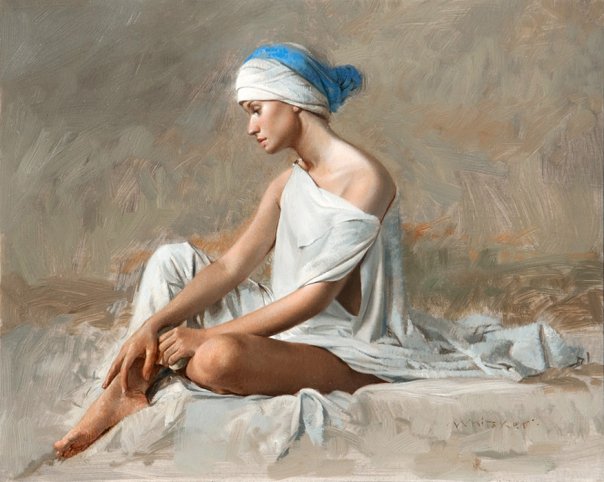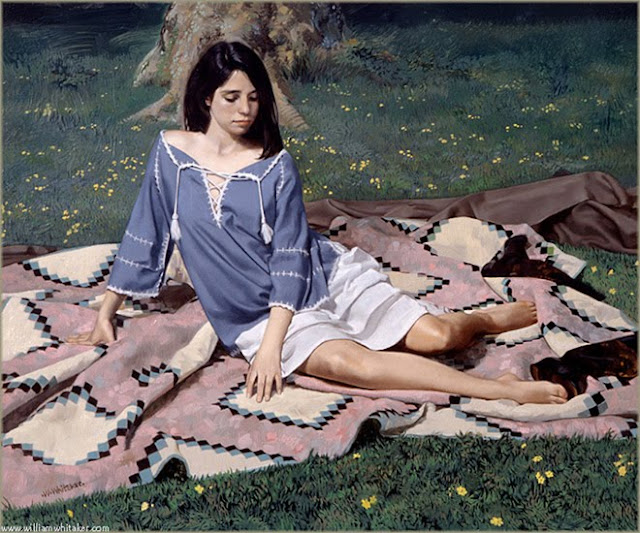I talked my good buddy, Sandra Phillips, into marrying me about sixteen years ago. We live in a pretty good house on the beach of ancient Lake Bonneville overlooking Utah Valley. Sandra paints watercolors in an upstairs studio. I have a studio behind the house that functions nicely. Adrian Gottlieb called it, "The most awesome a studio can get without actually being Frederick Leighton's studio"
We have paints, brushes, books, props, easels, crates, paper, canvas, pencils, solvents, costumes, computers and banjos everywhere.
We are fixated on art. We are boring company.
We have paints, brushes, books, props, easels, crates, paper, canvas, pencils, solvents, costumes, computers and banjos everywhere.
We are fixated on art. We are boring company.
The only son of an artist father, William Whitaker grew up in the special world of the working artist. He had access to the finest art materials and was painting in watercolor and oil at the age of six. His fondest early memories are of the sights sounds and smells of the art studio.
The art world of his childhood and youth was the brave new world of abstract expressionism and until he was well out of college his natural inclination to draw accurately and his love for traditional realism was a source of inner conflict. Nevertheless he was fortunate, starting at age 17, to receive a thorough grounding in academic figure drawing and painting from the portrait painter Alvin Gittins at the University of Utah, and after exploring other styles he followed his heart into traditional art.
Whitaker loves to paint from life in an old fashioned studio. No matter what direction his art takes him, he always comes back to the model in the studio, the form bathed in the beautiful quiet cool light coming down from a high north window. He refers to this kind of seeing and painting as the Old Testament of art and feels there is enough magic to engage him there for the rest of his life.
He believes the value of painting is to be found in its spiritual power. Having been told all his life that the kind of painting he enjoys is dead, he takes quiet comfort in lovingly attempting to capture something the camera cannot see. He is also delighted that there are so many wonderfully talented young artists who are not bound or inhibited by contemporary art world conventions and who are out to paint beautifully crafted pictures without apology.
He has been a professional artist since 1965, during which time he has conducted workshops and been a university art professor. He continues to work with one or two advanced student artists for fun. He paints about three or four hours every day ands spends the rest of the time trying not to ruin any good work he's done
The art world of his childhood and youth was the brave new world of abstract expressionism and until he was well out of college his natural inclination to draw accurately and his love for traditional realism was a source of inner conflict. Nevertheless he was fortunate, starting at age 17, to receive a thorough grounding in academic figure drawing and painting from the portrait painter Alvin Gittins at the University of Utah, and after exploring other styles he followed his heart into traditional art.
Whitaker loves to paint from life in an old fashioned studio. No matter what direction his art takes him, he always comes back to the model in the studio, the form bathed in the beautiful quiet cool light coming down from a high north window. He refers to this kind of seeing and painting as the Old Testament of art and feels there is enough magic to engage him there for the rest of his life.
He believes the value of painting is to be found in its spiritual power. Having been told all his life that the kind of painting he enjoys is dead, he takes quiet comfort in lovingly attempting to capture something the camera cannot see. He is also delighted that there are so many wonderfully talented young artists who are not bound or inhibited by contemporary art world conventions and who are out to paint beautifully crafted pictures without apology.
He has been a professional artist since 1965, during which time he has conducted workshops and been a university art professor. He continues to work with one or two advanced student artists for fun. He paints about three or four hours every day ands spends the rest of the time trying not to ruin any good work he's done
Claire Peterson


























0 Comments